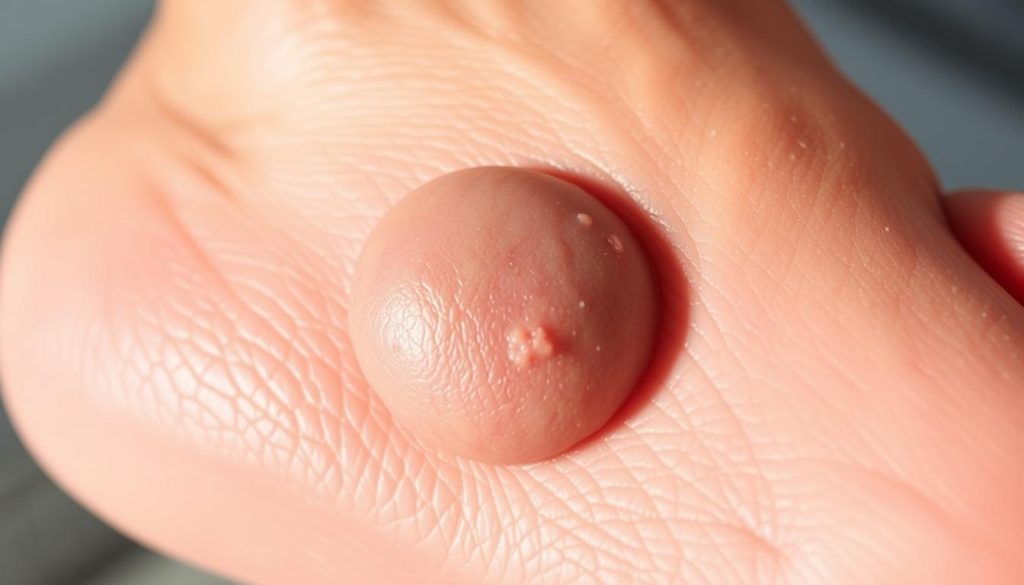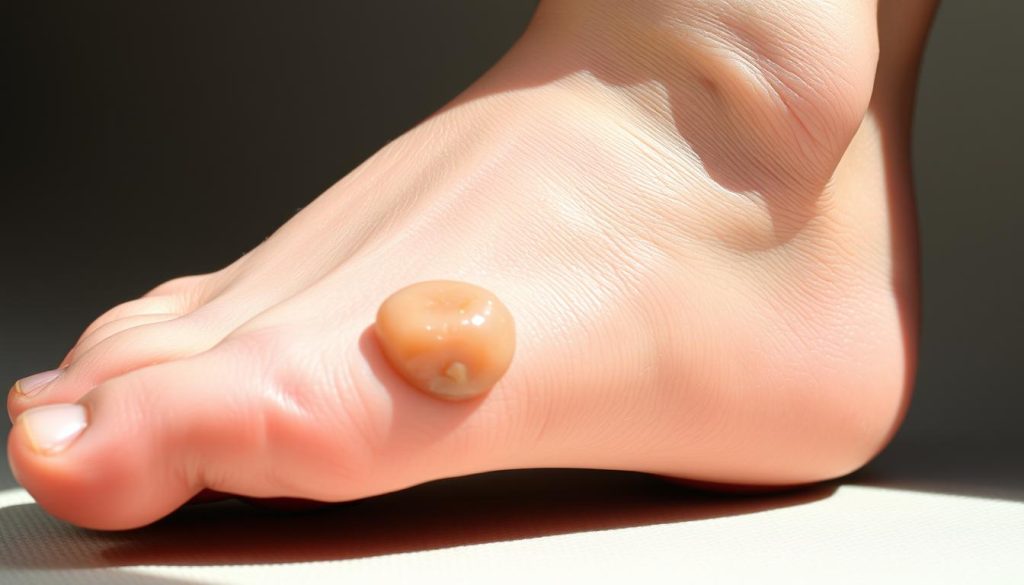Discovering a lump in the sole of your foot can be unsettling. The causes can range from harmless cysts to serious conditions. It’s important to understand the cause of a sole of foot bump and the relief options for foot growth.
When you feel a foot pain lump, it’s a sign to seek help. The right treatment depends on the diagnosis. Early action and knowledge can greatly improve your situation. Let’s explore the lump in sole of foot and how to find relief together.
Understanding the Lump in Sole of Foot Phenomenon
Finding a lump in the sole of your foot can be puzzling and worrying. Sometimes, these lumps show up without any pain, making it hard to know if they’re serious. This part will talk about what these lumps mean, including foot swelling, sole of foot bump, and foot growth.

Lumps on the sole of the foot can look different. They might be small and hard or big and soft. Seeing any foot growth can worry you, as it might mean there’s something wrong inside.
- Sensation: The lump might not hurt or could be uncomfortable when you walk or wear shoes.
- Appearance: It could be smooth, round, or look odd in texture and color.
- Concern: Even if it’s usually okay, any lump that stays should be checked by a doctor.
These lumps, like foot swelling and bumps, can be caused by many things. They might be harmless cysts or could be signs of serious health problems. A sole of foot bump is common, seen in people who are active or have foot injuries. But, if you notice any unusual foot growth, it’s important to see a doctor.
Watching how the lump changes is key. If it gets bigger, looks different, or hurts more, get a doctor’s opinion. Keeping track of these changes helps doctors find the right treatment fast. Acting quickly can really help your health.
Remember, the internet is great for health tips, but it can’t replace a doctor’s advice. If you have ongoing foot problems, see a healthcare professional.
Common Causes of Foot Lumps and Bumps
It’s important to know why foot lumps happen. They can come from injuries, benign tumors, or soft tissue issues. We’ll look at the main reasons and what they mean for your foot health.
Injuries and Trauma Leading to Foot Swelling
Things like sprains, fractures, and blunt trauma can cause foot lumps. These injuries lead to swelling, bruises, and sometimes a lump from bleeding or swelling. Spotting these signs early helps avoid bigger problems and speeds up recovery.
Benign Foot Tumors and Soft Tissue Masses
Not every lump is from an injury. Often, a benign foot tumor or soft tissue mass foot is the cause. These include lipomas, ganglion cysts, or plantar fibromas. They’re usually not harmful but can be uncomfortable or affect how you walk.

| Condition | Description | Common Symptoms | Treatment Options |
|---|---|---|---|
| Ganglion Cyst | Cyst filled with a jelly-like fluid often occurring near joints or tendons | Visible bump, discomfort, pain when pressing or when using joint | Observation, footwear adjustment, aspiration, surgery |
| Lipoma | Soft, rubbery benign tumor composed of fat cells | Soft lump, usually painless | Usually none needed unless painful or growing |
| Plantar Fibroma | Fibrous knot or nodule in the plantar fascia of the foot | Firm mass in the arch of the foot, pain with pressure or standing | Orthotic devices, steroid injections, surgery |
Lump in Sole of Foot: Identifying Plantar Fibromas
A plantar fibroma is a fibrous knot or nodule in the arch of the foot. It forms in the plantar fascia. This benign mass, known as a sole of foot bump or plantar fibroma, can cause discomfort and hinder daily activities.
It’s important to understand what a foot lump is to manage it well. Unlike other lumps, plantar fibromas are firm and stick to the foot’s structures. This makes them unique in texture and fixed in place.
To help people spot and tell apart a plantar fibroma from other foot lumps, here’s a quick guide:
| Feature | Plantar Fibroma | Other Foot Lumps |
|---|---|---|
| Consistency | Firm | Soft to variable |
| Location | Arch of the foot | Various areas of the foot |
| Mobility | Non-movable | Movable |
| Shape | Localized nodule | Irregular shapes |
If you notice a sole of foot bump, remember these traits. Then, get a professional diagnosis. Even though a plantar fibroma is benign, it can cause discomfort. It might need special care to manage symptoms well.
Spotting a plantar fibroma early helps in getting the right treatment. It keeps your foot healthy, mobile, and comfortable.
Foot Growth: When to Be Concerned About Cancer
Understanding a foot growth is key for diagnosis and treatment. Knowing if it’s a harmless tumor or a dangerous cancer is important. We will look at the differences and signs that mean you need to see a doctor.
Differentiating Benign and Malignant Foot Growths
A benign foot tumor is a non-cancerous lump that doesn’t spread. Examples include lipomas and fibromas, which are usually not dangerous. But, malignant foot growths are cancerous and can spread quickly.
Melanoma of the foot is very serious and needs quick medical help. It grows fast.
Key Symptoms That Indicate Medical Attention Is Required
Watch foot growths for any signs of cancer. Look for fast growth, pain, irregular shape, color changes, or bleeding. These signs mean you might have a cancerous growth.
Early detection is vital for treating foot growths, like cancer. Knowing the signs helps get the right care. Always check for changes in your foot lumps and see a doctor if needed.
Diagnosing a Foot Lump: Tests and Procedures
When you notice a foot lump, it’s important to get it checked right away. Diagnosing a foot lump helps find the best treatment. Doctors use many methods, from simple checks to high-tech scans. They start by looking at the lump’s size, shape, and feel.
For a plantar fascia lump, doctors might do tests for foot swelling. These tests help find what’s causing the problem. Here’s what these tests are:
- X-Rays: They help find bone problems and see how the lump affects bones.
- Ultrasound: It shows soft tissues and what the lump is made of.
- MRI (Magnetic Resonance Imaging): It gives a detailed look at both hard and soft tissues. This is great for tricky cases.
These tools help not just with plantar fascia lumps but also with many other foot issues.
| Test Type | Diagnostic Focus | Utility in Foot Lump Analysis |
|---|---|---|
| X-Ray | Bone structure and alignment | Detects fractures, displacements |
| Ultrasound | Soft tissue assessment | Identifies fluid collections, soft tissue growth |
| MRI | Detailed tissue analysis | Exceptional for complex diagnoses |
Using all these tests helps doctors get a clear picture of the lump. This is key for making a good treatment plan. You can learn more about diagnosing foot lumps at this link.
Navigating Treatment Options for a Foot Lump
Understanding the different ways to treat a foot lump can help a lot. You can try home remedies or seek medical help. Each method is good for different types of lumps.
Home Remedies and Non-invasive Relief Measures
For many, starting with simple home remedies is a good first step. These include:
- Applying ice packs to reduce swelling and numb the affected area
- Keeping the foot elevated to decrease blood flow to the swelling, which helps it shrink
- Using over-the-counter pain relievers to manage discomfort
- Limiting activities that put pressure on the lump
These steps are good for minor cases. But, always get professional advice too.
Medical Interventions for Soft Tissue Masses in Foot
For bigger or more serious lumps, you might need medical help. Options include:
- Corticosteroid injections to reduce inflammation and pain
- Surgical removal if the lump is big, growing, or very painful
- Physical therapy to strengthen tissues and improve mobility after treatment
Each medical option has its own benefits and risks. Always talk to a doctor before starting treatment.
Choosing the right treatment for a foot lump depends on the diagnosis and your situation. Whether you try home remedies or medical treatments, knowing the cause and effects helps get better results.
The Role of the Plantar Fascia in Sole Bumps
It’s important to know how problems with the plantar fascia can cause a lump in sole of foot. This thick band of tissue supports your foot’s arch. But, too much strain can lead to plantar fasciitis, causing foot swelling and bumps.
A plantar fascia lump is when small, fibrous nodules form in the fascia. These lumps are not cancerous but can hurt. They’re often mistaken for more serious issues. Here’s how to tell them apart:
- Location: Usually found in the arch area of the foot
- Texture: Firm, unlike softer swellings from fluid buildup
- Symptoms: Sharp pain when pressing on the lump, sometimes spreading to nearby areas
Wear and tear, bad shoes, extra weight, or a high arch can stress the plantar fascia. This stress can cause foot swelling and pain.
Spotting the cause of a lump in sole of foot is key. But, don’t ignore the plantar fascia’s role and problems. A doctor’s check-up is needed to tell if it’s a harmless lump or something more serious.
Exploring the Connection Between Foot Pain and Lumps
It’s important to understand how foot pain and lumps are connected. This knowledge helps doctors diagnose and treat these issues effectively. Pain from lumps on the foot can give clues about their cause and nature. We’ll look at how pain patterns can help figure out the severity of lump pain.
How Pain Patterns Can Indicate the Cause of Foot Lump
Pain is a key sign of what’s happening with a foot lump. Sharp pain when pressure is applied might mean a hardened cyst or a deep growth. On the other hand, a constant throbbing pain could be from a softer, less serious growth.
Understanding these pain patterns helps doctors find the cause of foot lumps. It also helps them choose the best treatment.
Assessing the Severity of Pain Associated with Sole Lumps
Not all foot pain is the same. It’s important to know how bad the pain is, how often it happens, and how it affects movement. For example, mild pain that comes and goes might not need urgent treatment.
But, if the pain is severe and doesn’t let you move around, it could be a sign of something serious. Doctors need to assess pain like this to decide on the right treatment. This is key if they find a link between pain and foot tumors.
How a Plantar Fascia Lump Can Affect Your Mobility
A plantar fascia lump is more than just a bump on your foot. It can cause big problems with how you move, affecting your daily life. This lump is usually on the bottom of your foot and changes how you walk, stand, and even sit.
Having a plantar fascia lump can hurt when you walk, run, or stand for a long time. It can change how you walk and might lead to other foot problems. This is because the pressure on your foot is not evenly spread.
The lump can also make your foot’s arch stiff. This stiffness makes it hard to move your foot freely. It can make simple movements feel stiff and hard to do.
Here are some ways to prevent and treat this problem:
- Using orthotic devices like insoles or custom shoes to spread out the pressure and ease pain.
- Doing exercises to stretch and strengthen the foot’s arch and muscles.
- Using treatments like ice and massage to reduce swelling and help heal.
It’s also important to know how a plantar fascia lump might change or react to treatment. This knowledge helps manage the problem and improve your foot’s mobility over time.
| Impact | Short-Term Issues | Long-Term Issues |
|---|---|---|
| Gait Alterations | Limping, favoring one foot | Chronic pain, joint misalignments |
| Activity Limitation | Decreased walking/running ability | Possible avoidance of certain activities |
| Quality of Life | Immediate discomfort and frustration | Long-term impact on personal mobility, possible need for assistive devices |
Preventative Measures: Reducing the Risk of Developing Foot Lumps
Starting early with preventative measures can greatly help keep your feet healthy. Choosing the right shoes and making lifestyle changes can stop foot problems before they start.
Footwear Choices for Minimizing Foot Trauma
Wearing the right shoes is more than just a style choice. It’s about supporting your feet and reducing daily stress. Look for shoes that fit well, offer good arch support, and have cushioned soles. Here’s a closer look at what works best:
| Footwear Type | Features | Recommended For |
|---|---|---|
| Orthopedic Shoes | Built-in arch support, extra cushioning | Individuals with existing foot conditions or those prone to foot pains |
| Athletic Sneakers | Shock-absorbing soles, breathable material | Daily walking, exercising |
| Supportive Sandals | Contoured footbed, adjustable straps | Summer activities, casual wear |
Lifestyle Adjustments for Foot Health Maintenance
To keep your feet healthy, making lifestyle changes is key. Regular exercise strengthens your foot muscles. And, keeping a healthy weight reduces foot strain. Here are some tips to help:
- Maintain an active lifestyle to enhance circulation and foot strength.
- Practice foot exercises to improve flexibility and reduce pressure on the plantar fascia.
- Limit wearing high heels or pointed shoes that can exacerbate foot strain.
By choosing the right shoes and making smart lifestyle choices, you can prevent foot lumps. Keeping these tips in mind will help keep your feet healthy and pain-free.
Pediatric Concerns: Lumps in Children’s Feet
Understanding why lumps appear on kids’ feet is key. These lumps can be simple cysts or serious issues that need a doctor. Knowing the difference is important.
Foot swelling and lumps in kids are different from adults. It’s hard to tell if it’s just growing pains or something serious. Seeing a doctor early can help a lot.
Here are some things parents should watch for:
- Foot lumps that grow with the child.
- Swelling that doesn’t go away after an injury.
- Pain when the child walks or plays.
This issue, while often not serious, needs to be checked out. It’s important to catch any serious problems early.
| Condition | Common Symptoms | Common Treatments |
|---|---|---|
| Pediatric Flatfoot | Minor pain, Visible swelling, Difficulty in foot motion | Custom orthotics, Physical therapy |
| Plantar Fibroma | Firm mass on the arch, Mild to moderate discomfort | MRI scans, Corticosteroid injections |
| Juvenile Bunion | Swelling at the base of the big toe, Visible bump | Wider shoes, Surgery in severe cases |
If you see a lump on your child’s foot, don’t wait to see a doctor. Even if it’s just a little pain or trouble moving. Doctors can usually check it out quickly and tell you what to do next.
Alternative Remedies and Their Efficacy
Looking into non-traditional ways can help those with foot problems. This part talks about the success of alternative remedies for foot lumps. It also compares them to usual medical treatments.
Natural Treatments and Their Impact on Foot Swelling
It’s important to know about natural treatments for foot swelling. These are gentler than medicines. Turmeric and arnica are good because they fight inflammation and swelling.
Using natural fibers for compression can also help reduce swelling. This makes your feet feel better.
Physical Therapy and Stretching Exercises for Lump Relief
Physical therapy for foot lumps uses special exercises. These exercises help make the lump smaller and less painful. Stretching and strengthening can improve how well you move.
Below is a quick look at how alternative remedies and physical therapy work on foot lumps.
| Treatment Type | Primary Benefits | Usage Recommendations |
|---|---|---|
| Herbal Compresses | Reduces swelling, eases pain | Apply directly to affected area twice daily |
| Compression Therapy | Improves circulation, decreases swelling | Wear compression socks for 3-4 hours daily |
| Physical Therapy | Increases flexibility, reduces lump size | Engage in therapy 2-3 times per week |
When Surgery Is Necessary: Understanding the Process
In cases where non-invasive treatments have failed, surgery for sole of foot bump is an option. This part explains when and why plantar fibroma surgical intervention is needed. It also covers what it involves.
Foot lump removal surgery is suggested when pain is severe. It aims to remove the lump and prevent future problems. Knowing the surgical options and what to expect can help patients make informed decisions.
- Evaluation and Diagnosis: A specialist will assess the lump and discuss surgery options.
- Choosing the Right Procedure: The type of surgery depends on the lump’s size, location, and type.
- Pre-Surgical Preparation: Patients may have tests and get instructions for surgery preparation.
- Surgical Procedure: The surgery, where foot lump removal is done under anesthesia and in a clean environment.
- Post-Operative Care: Steps and treatments to aid in recovery and prevent recurrence.
The aim of plantar fibroma surgical intervention is to remove the lump and improve foot function. This helps patients live without pain and resume their activities.
Deciding on surgery for sole of foot bump can be scary. But, with the right information and a skilled surgical team, it can greatly improve foot health and life quality.
Navigating the Recovery Journey Post-Treatment for Foot Lumps
The road to recovery after treating foot lumps involves key steps. These steps help the body heal well and lower the chance of the lump coming back. People going through this recovery need a mix of rehabilitation and coping strategies to do well.
Rehabilitation Steps Following Surgical Interventions
Rehab after surgery for foot lumps is key to getting back to normal. The process has several stages:
- First, rest and keep the foot from moving to help it heal.
- Then, slowly start walking again with help from a doctor.
- Next, do exercises to make the foot strong and move freely.
- Lastly, wear special shoes or use orthotics to support the foot.
Coping Strategies and Support Systems During Healing
Rehab is important, but so is the emotional side of healing. Strategies for coping with foot growth treatment include:
- Setting achievable goals for recovery.
- Seeing doctors regularly for check-ups.
- Talking to support groups or counselors about recovery.
- Using stress-reducing activities like meditation.
Using these strategies helps deal with the emotional side of healing. They play a big role in making recovery smoother.
It’s important for patients and doctors to focus on both physical and mental health. This balanced approach helps with recovery and builds strength for the future.
Success Stories: Overcoming a Lump in Sole of Foot
Many people have found relief from foot problems, sharing lump in sole of foot success stories. These stories show the personal struggles and the victorious foot lump treatments that helped them.
One common issue is overcoming plantar fibroma, a benign but persistent lump. Here are a few recovery stories:
- A patient had long-lasting pain from a plantar fibroma. They tried several non-invasive methods before trying cryosurgery. This treatment greatly reduced their pain and lump size, allowing them to enjoy daily activities again.
- Another case involved laser therapy and physical therapy. This combination helped another person manage their pain and dissolve the fibrous tissue. It’s another success story in victorious foot lump treatments.
These stories offer hope and valuable insights to those facing similar foot issues.
Ensuring Effective Communication with Your Podiatrist
Good health starts with clear talk between you and your doctor. This is key when you have a lump in your foot’s sole. A detailed lump in sole of foot consultation helps find out what’s wrong and how to fix it. It’s important to share your symptoms clearly, as small details can make a big difference.
Before your foot lump check-up, write down all your symptoms and when they started. Also, note what makes them better or worse. This helps your podiatrist understand you better and can lead to better treatment. Don’t be shy to ask questions about your condition and treatment options. Knowing more helps you talk about your health better.
Good communication is a team effort between you and your podiatrist. Look for a doctor who is easy to talk to and willing to discuss your concerns. Being open and active in your care helps you get better faster from problems like a foot lump.
FAQ
Q: What could cause a lump in the sole of my foot?
A: A lump in your foot’s sole can be due to injuries, benign tumors like plantar fibromas, or soft tissue masses. If you notice a bump or pain, see a doctor to find out why.
Q: How can I find relief from foot pain associated with a lump?
A: For foot pain, try home remedies like icing, resting, and elevating your foot. Doctors might suggest injections or surgery. Always talk to a doctor before starting any treatment.
Q: When should I be concerned about cancer regarding a growth in my foot?
A: Most foot growths are not cancerous. But, watch for sudden size, shape, or color changes, or severe pain. See a doctor for any new or worsening lumps.
Q: What types of tests are used to diagnose a lump in the sole of the foot?
A: Doctors use a physical exam and imaging tests like X-rays, ultrasounds, or MRIs. These help figure out what the lump is and how to treat it.
Q: Can a plantar fascia lump affect my mobility?
A: Yes, a plantar fascia lump can change how you walk and cause pain. Treatment can help you move better and feel less pain.
Q: Are there any preventative measures to reduce the risk of developing foot lumps?
A: Wear shoes that fit well and support your feet. Take care of your feet and make healthy lifestyle choices. This can help prevent foot lumps.
Q: What should I do if my child develops a lump in their foot?
A: Foot lumps in kids are often not serious. But, it’s important to have a doctor check it out. This is true if the lump hurts or changes how your child walks.
Q: How effective are alternative remedies for reducing foot swelling and lumps?
A: Some natural treatments and exercises might help with swelling and comfort. But, their effectiveness varies. Talk to your doctor to see if they’re right for you.
Q: What can I expect during recovery after treatment for a foot lump?
A: Recovery might include physical therapy and following your doctor’s advice. You might also need to make lifestyle changes. Support from others can help a lot during this time.
Q: How can I ensure effective communication with my podiatrist about my foot lump?
A: To talk well with your podiatrist, be ready to share your symptoms and ask questions. Understand your treatment plan. Clear communication is key for good care.

















